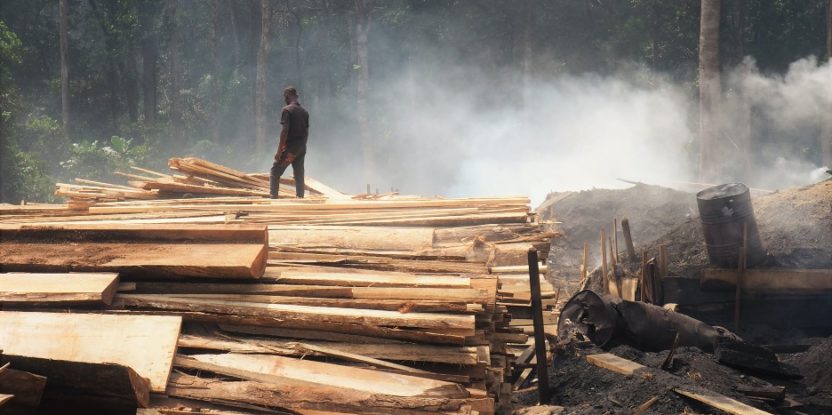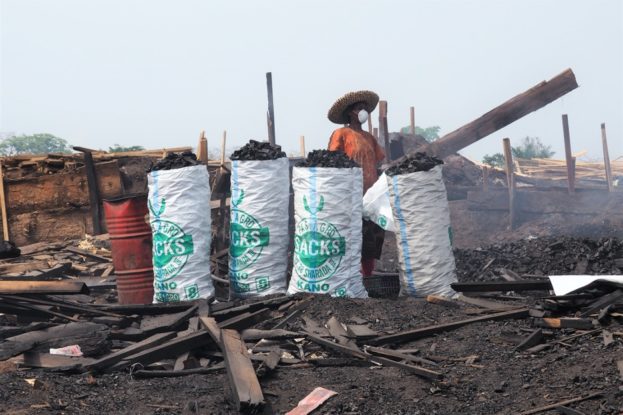
This article was originally published in the print edition of the Cameroon Tribune on Aug. 25, 2020.
The circular economy is an economic and industrial model that keeps products, including their components and materials, in circulation for as long as possible to promote sustainability.
In this system, the components of an end-of-life product are used over and over again to recreate value, and industrial, agricultural, and household residues are recovered to make new products. This system therefore keeps waste and use of resources to a minimum.
As Cameroon works towards becoming an “emergent country,” shifting the economy from a linear model towards circularity will be key to ensure efficient resource management, create jobs, and reduce the impact of economic development on the environment. And the wood fuel sector is an excellent starting point for this transformation.
In Cameroon, at least 75 percent of households use wood fuel for cooking, according to the National Household Survey. Many businesses, including bakeries, restaurants, laundries, ironsmiths, and fish and meat smokers, also depend on it for their economic survival.
According to 2012 data, in Cameroon the annual urban demand for wood fuel is estimated at 2.2 million tons of firewood and 356,530 tons of charcoal. Wood fuel production already accounts for 73 percent of the country’s total timber harvest, and demand will keep rising as population and cities continue to grow. Unless we act, the potential impact on our forests could be catastrophic.
Sustainable options
The good news is that a significant part of the demand could be met by sustainable alternatives produced from waste. The solution therefore lies in the circular economy.
To start with, the potential for producing briquettes from household waste is enormous, and they can even have a better energy efficiency than traditional charcoal.
In Douala, the Center for International Forestry Research (CIFOR) supports a small company called Kemit Ecology, which uses waste such as plantain peels and maize leaves to produce ecological charcoal. This is a win-win initiative that supports urban waste management and provides an affordable and practical household energy option, while reducing pressure on the natural ecosystem. Our goal is to support the replicability of this model and help supply ecological briquettes to other urban areas in Cameroon.
Sawmill residues represent another major opportunity. One of the government’s main development strategies in the forestry sector is to promote timber processing within the country as a source of revenues and job creation. However, there is no strategy to encourage the use of residues to produce other wood products.
Although Cameroon has had some successful experiences producing ecological charcoal in forest concessions in the East region, the challenge lies in scaling up. Potentially, this could help Cameroon and other countries in the Congo Basin to avoid, despite the prevailing myth of limitless resource abundance, the further widening of the gap between the needs of the growing urban population and the natural potential of our forests.
For the past year, thanks to funding from the European Union and the assistance of various governmental institutions, the German Agency for International Cooperation (GIZ) and civil society organizations, CIFOR has been working to create greater awareness of these issues among timber processing companies and charcoal producers, while calling upon the private sector to include waste management in their social corporate responsibility strategies. But up to now, the private sector has not been fully convinced. We hope that incentives will be found to nudge all parties towards sustainability.

Cameroon has already had some success producing charcoal from waste. CIFOR/Ahtziri Gonzalez
What if the government stepped in?
In Cameroon, wood fuel supply and trade has not been included prominently enough in national policies, and there are significant legal and institutional shortfalls that contribute to illegal practices and the overexploitation of forest resources. The transition to greater sustainability will be difficult unless the government supports green wood fuel value chains by recovering waste and using more efficient carbonization methods to create charcoal.
There are many possible incentives, such as making an agreement between the Ministry of Forests and Wildlife (MINFOF) and forestry companies to supply scrap wood and maximize recovery; giving tax exemptions or introducing a flexible tax system for those companies providing sustainable solutions; gradually reducing new charcoal production permits as sustainable alternatives become more competitive; and giving priority access for green charcoal to enter the main consumer centers located in the country’s most fragile environments, especially the North and the Far-North regions.
Finally, supportive policies will be essential to carry out much-needed transformations to move the wood fuel sector towards a circular model, and to ensure that Cameroon’s abundant forest resources benefit present and future generations.
We want you to share Forests News content, which is licensed under Creative Commons Attribution-NonCommercial-ShareAlike 4.0 International (CC BY-NC-SA 4.0). This means you are free to redistribute our material for non-commercial purposes. All we ask is that you give Forests News appropriate credit and link to the original Forests News content, indicate if changes were made, and distribute your contributions under the same Creative Commons license. You must notify Forests News if you repost, reprint or reuse our materials by contacting forestsnews@cifor-icraf.org.